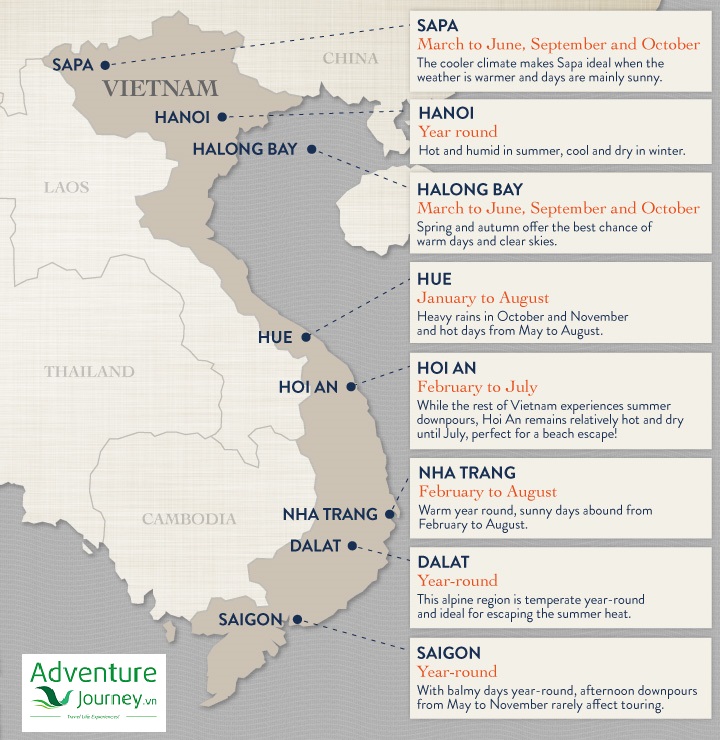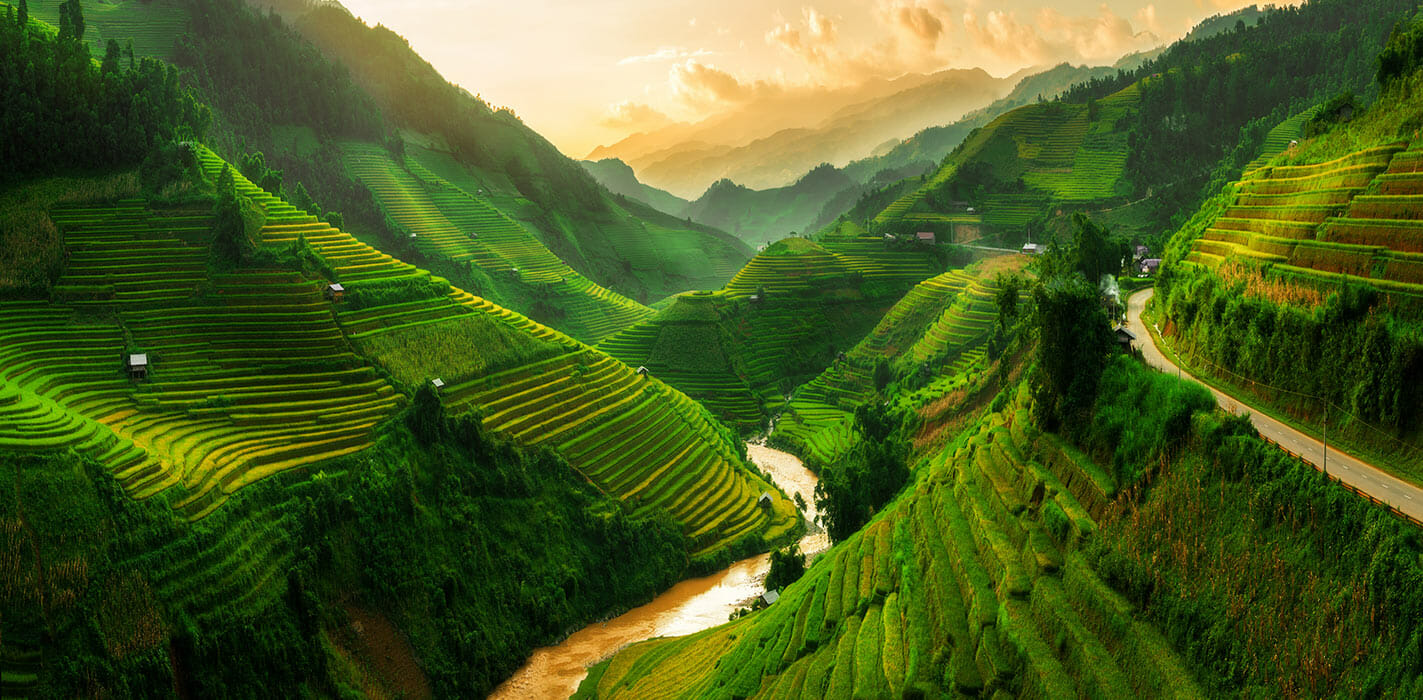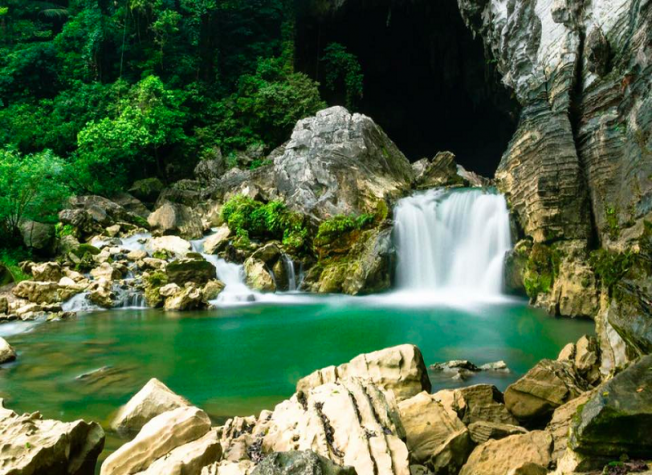Best Time to Travel to Vietnam to Avoid the Bad Weather
Vietnam Weather and Climate: Vietnam's Climate, being located in the tropics and strongly influenced by the South China Sea (The East Sea) has a monsoon-influenced tropical climate typical of that of mainland Southeast Asia. In the north, the climate is monsoonal with four distinct seasons Spring (February, March, April), Summer (May, June, July), Autumn (August, September, October), and Winter (November, December, January), while in the south (areas south of the Hải Vân Pass), the climate is tropical monsoon with two main seasons (rainy and dry).

In addition temperate climate exists in mountainous areas, which are found in Sa Pa, Da Lat while a more continental climate exists in Lai Chau Province and Son La Province. The diverse topography, wide range of latitudes (Vietnam spans over 15° of latitude), and influences from the South China Sea lead to climatic conditions varying significantly between regions. 20% of Vietnam's total surface area is low-elevation coastal area making the country highly vulnerable to climate change effects and the rising sea levels in particular.
Time in Vietnam: Vietnam Time Zone is UTC+7, following Indochina Time (ITC), which is seven hours ahead of Coordinated Universal Time (UTC). This country does not observe daylight saving time (DST), so this time zone is applicable all year round. Vietnam shares the same time zone with not only countries in Indochina Time but also other countries and regions, including:
- Indochina time: Laos, Thailand, Cambodia
- Indonesia: Sumatra, Java, and West and Central Kalimantan
- Russia: Siberian Federal District
- Mongolia: the west of Mongolia (Khovd, Uvs, Bayan-Ölgii, Govi-Altai, and Zavkhan)
When is the Best Time & Worst Time to Visit Vietnam? There is no worst time to travel to Vietnam. But to avoid Rain, Hot, Humid or Rainy Weather. The Best Time to Travel to Vietnam is in spring (February to April) and autumn (August to October). The temperatures are more moderate and rainfall is lighter. In spring, March and April have the lowest rainfall across all destinations and temperatures are pleasant, though still cool in the far north.
Vietnam Weather Forecast Condition by Months
|
Months |
Regions |
Temperature |
Humidity |
Rain Falls |
Rain Days |
|
January |
North |
14ºC / 20ºC |
65% |
11mm |
1 day |
|
Central |
21ºC / 32ºC |
87% |
45mm |
4 days |
|
|
South |
19ºC / 25ºC |
66% |
29mm |
1 day |
|
|
February |
North |
16.5°C / 23.4°C |
65% |
25mm |
4 days |
|
Central |
19.5°C / 24.0°C |
86% |
58mm |
9 days |
|
|
South |
23.3°C / 34°C |
56% |
37mm |
5 days |
|
|
March |
North |
26°C / 15°C |
76% |
43mm |
5.8 days |
|
Central |
28° / 22°C |
83% |
24mm |
2 days |
|
|
South |
34° / 23°C |
74% |
13.8mm |
1 day |
|
|
April |
North |
28°C / 22°C |
75% |
60.3mm |
5 days |
|
Central |
31°C/ 24°C |
82% |
30.6mm |
2 days |
|
|
South |
35°C / 25°C |
63% |
10.8mm |
1 day |
|
|
May |
North |
32°C / 24°C |
75% |
133mm |
7 days |
|
Central |
33°C / 25°C |
80% |
63mm |
3 days |
|
|
South |
34°C / 24°C |
70% |
66.5mm |
2 days |
|
|
June |
North |
34°C / 26°C |
71% |
162mm |
8 days |
|
Central |
35°C / 26°C |
73% |
55mm |
3 days |
|
|
South |
33°C / 23°C |
75% |
114mm |
7 days |
|
|
July |
North |
33°C / 26°C |
72% |
178mm |
8 days |
|
Central |
34°C / 26°C |
74% |
82.9mm |
5 days |
|
|
South |
32°C / 23°C |
81.10% |
13.8mm |
1 day |
|
|
August |
North |
26°C / 15°C |
76% |
89mm |
8 days |
|
Central |
34°C / 25°C |
80.30% |
114mm |
6 days |
|
|
South |
32°C / 23°C |
80.00% |
101mm |
7 days |
|
|
September |
North |
32°C / 25°C |
79.40% |
109mm |
5 days |
|
Central |
32°C / 24°C |
82.70% |
307mm |
10 days |
|
|
South |
32°C / 23°C |
81.60% |
79.8mm |
6 days |
|
|
October |
North |
29°C / 22°C |
74% |
77mm |
4 days |
|
Central |
29°C / 23°C |
86% |
477mm |
14 days |
|
|
South |
31°C / 23°C |
75% |
117mm |
5 days |
|
|
November |
North |
26°C / 19°C |
75% |
40mm |
2 days |
|
Central |
27°C / 21°C |
85% |
414mm |
14 days |
|
|
South |
32°C / 22°C |
75% |
35.7mm |
2 days |
|
|
December |
North |
22°C / 15°C |
77% |
16mm |
1 day |
|
Central |
25°C / 20°C |
82% |
215mm |
13 days |
|
|
South |
32°C / 21°C |
72% |
17.5mm |
1 day |
If you plan to see the whole country, deciding on the best time to visit Vietnam can be complicated. Vietnam is over 1,000km (600 miles) in length and has huge regional diversity, however as a truly year-round destination, travel to any part of Vietnam during any season is possible. Here is your guide on what to expect, where and when:
Best Time to visit Sapa Town and North West Vietnam: Best Things to Do in Sapa
Set in the mountains of northern Vietnam, Sapa’s climate is very seasonal with temperatures reaching 29°C (84°F) in summer down to freezing in winter. Humidity ranges from 75% to 90%, but summer months are the wettest, especially July and August. The best time to travel is March and April for warm and dry weather or go in October and November for cooler climes and clear days.
Best Month to visit Hanoi Capital City and Red River Delta: Best Things to Do in Hanoi
Summer in Hanoi runs from May to September and brings heat and humidity, with average temperatures reaching 32°C (90°F) accompanied by refreshingly short bouts of heavy rain. These tropical downpours generally arrive in the afternoons, and despite being wet, summer months have the highest number of hours of sunshine. Winter is cooler and can bring fog and clouds but little rain, and the average temperature is 17°C (62°F). The best time to go is October and November, as days are not too hot with averages around 21°C (70°F) with less rain and plenty of sunshine.
Best time to Travel to Halong Bay & North East Vietnam: Halong Bay Travel Guide
Halong Bay is often covered in mist, which reduces visibility but adds to the atmosphere. From March to May, skies over Halong Bay are usually clear and blue and temperatures are pleasant. During summer, from May to November, you can expect days to be warm and humid with refreshing afternoon showers. Winter, from December to February, can be quite cold. The best time to travel is spring or autumn for the best chance of warm days and clear skies, perfect for cruising.
Best Time to visit Hue City and Phong Nha National Park: Best Things to Do in Phong Nha
Near Hoi An in central Vietnam, Hue & Phong Nha has a wet season from September to December with brief but very heavy rains in October and November which can cause flooding. January to August is dry season though afternoon showers are still common, with average temperatures rising to the mid-thirties in the middle of summer.
Best Time to visit Dalat and Central Highland of Vietnam: Dalat Vietnam Travel Guide
Set in the mountains of central Vietnam, Dalat has pleasant temperature year-round which only vary by a few degrees month to month with minimum temperatures around 16°C (61°F) and maximums around 24°C (75°F). The green season is from May to November when the rainfall is heavier but the surrounding countryside is bursting with color.
Best Time to visit Saigon/Ho Chi Minh City & South Vietnam: Saigon Vietnam Travel Guide
Much closer to the equator, Saigon experiences consistently warm temperatures year-round, with balmy days averaging around 28°C (82°F). This tropical climate is marked by wet and dry season. From May to November, expect tropical downpours in the afternoon. Travel is rarely affected by the rain and everything is lush and green at this time.
Best Time to visit Beach Cities for Leisure in Vietnam: (See Also Best Beaches in Vietnam)
If you plan to visit Vietnam for its beautiful beaches, deciding when to go depends on which beach you want to visit. Reaching all the way from Central to Southern Vietnam down the east coast, there are beaches for every season.
The central coastline around Danang and Hoi An is warm year-round with temperatures peaking at 38°C (100°F) in the height of summer (July and August) and around 24°C (75°F) in winter. The dry season lasts from February until July. Go towards the end of the dry season if you like it hot, or the beginning if you prefer milder temperatures. From August to November rainfall increases and water levels rise. Occasional typhoons hit during this season.
Beaches in the south boast warm temperatures year-round with highs around 30°C (86°F). Nha Trang is affected by monsoon season from September to January, when typhoons do occasionally hit they often cause torrential rain and long drizzly days. Phu Quoc and Mui Ne experience wet season from June to September, and while Mui Ne has a microclimate with less rain, it still experiences some light afternoon showers. Con Dao is hot and humid year-round, with a wet season from May to November. Afternoon showers are generally brief, while July through September can see heavy rain at night. Read our complete Vietnam beach vacation guide.
See Also:

![]()
![]()
![]()
![]()
![]()
Best of Vietnam

Best Vietnamese Food You Have to Try in Vietnam
Best Food in Vietnam: Vietnamese Traditional Food is top World well known to be both healthy and...

10 Best National Parks in Vietnam
Vietnam Travel Guide: If you look for the Best Wildlife Discovery Experience in Vietnam, here are...
Read More
Best Souvenir to Buy in Vietnam
If you look for Best Things to Buy when traveling to Vietnam to bring home for your family & friends...
Read More
The 10 Best Places to Visit in Vietnam
Vietnam Travel Guide: Home to an extensive collection of historical and cultural attractions,...
Read More
Top 10 Museums You Should Not Miss in Vietnam
Vietnam, 4.000 years old country has a unique and lengthy history, culture with 54 ethnic groups. It...
Read MoreFind your trip
Vietnam Best Tours
Vietnam Car Rental
Vietnam Travel Blog
- Vietnamese People: Origin, History, Culture and Traditions
- Vietnam Currency: Best ATM and Places to Exchange Money
- Vietnam Map: Regions, Cities & Provinces Map of Vietnam
- What is illegal Things in Vietnam: Rules & Laws for Tourists
- Best Time to Travel to Vietnam to Avoid the Bad Weather
- Vietnam News: Population & Religions of 54 Ethnic Groups









